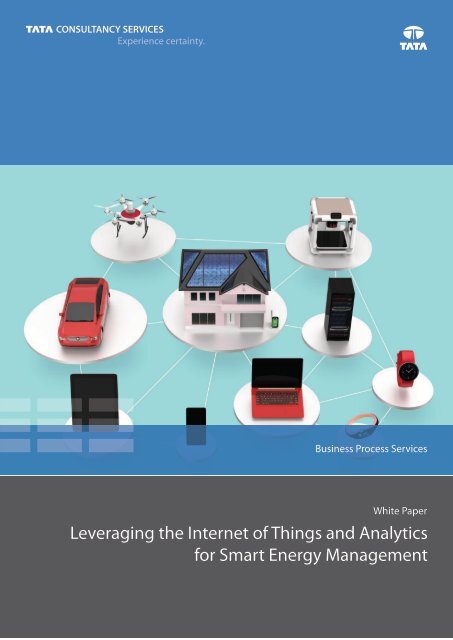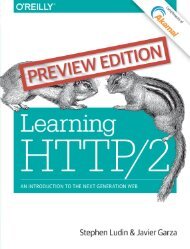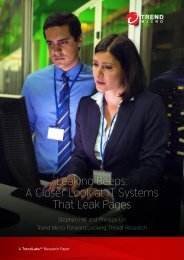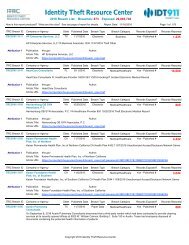Leveraging the Internet of Things and Analytics for Smart Energy Management
1UbH4b2
1UbH4b2
Create successful ePaper yourself
Turn your PDF publications into a flip-book with our unique Google optimized e-Paper software.
Business Process Services<br />
White Paper<br />
<strong>Leveraging</strong> <strong>the</strong> <strong>Internet</strong> <strong>of</strong> <strong>Things</strong> <strong>and</strong> <strong>Analytics</strong><br />
<strong>for</strong> <strong>Smart</strong> <strong>Energy</strong> <strong>Management</strong>
About <strong>the</strong> Author<br />
Akhil Bhardwaj<br />
Akhil Bhardwaj is a Senior Manager in <strong>the</strong> <strong>Analytics</strong> <strong>and</strong> Insights division <strong>of</strong> Tata<br />
Consultancy Services' (TCS) Business Process Services (BPS) unit. He has over 11 years <strong>of</strong><br />
experience in providing innovative solutions <strong>for</strong> a range <strong>of</strong> analytical problems across<br />
domains such as banking, supply chain, retail, <strong>and</strong> marketing. He is currently working on<br />
driving technological trans<strong>for</strong>mation in product based analytics. Bhardwaj graduated<br />
from <strong>the</strong> Indian Institute <strong>of</strong> Technology, Bombay <strong>and</strong> Xavier Labor Relations Institute,<br />
Jamshedpur.
Abstract<br />
The rising cost <strong>of</strong> energy is causing organizations to evaluate smart ways <strong>of</strong> saving<br />
energy. <strong>Energy</strong> suppliers are increasingly penalizing organizations that use<br />
inefficient assets or devices with a low power factor. Simultaneously, governments<br />
are raising <strong>the</strong> bar <strong>for</strong> compliance with energy st<strong>and</strong>ards <strong>and</strong> reduction in carbon<br />
footprints. <strong>Smart</strong> energy management systems (EMS), combined with <strong>the</strong> <strong>Internet</strong><br />
<strong>of</strong> <strong>Things</strong> (IoT), provide <strong>the</strong> ideal solution <strong>for</strong> <strong>the</strong>se pressing challenges by<br />
supporting radical changes in <strong>the</strong> way energy consumption is monitored <strong>and</strong><br />
managed.<br />
This paper examines how <strong>the</strong> combined power <strong>of</strong> <strong>the</strong> IoT <strong>and</strong> energy management<br />
systems can revolutionize energy management. It illustrates how <strong>the</strong>se systems<br />
leverage in<strong>for</strong>mation collected through different devices to automatically control<br />
operational parameters <strong>and</strong> minimize energy consumption across buildings or<br />
campuses. The paper also highlights <strong>the</strong> role <strong>of</strong> analytics in optimizing energy<br />
management by helping organizations make holistic sense <strong>of</strong> <strong>the</strong> large volumes <strong>of</strong><br />
data ga<strong>the</strong>red by various devices.
Contents<br />
The Need <strong>for</strong> <strong>Energy</strong> <strong>Management</strong> 5<br />
Planning <strong>for</strong> Efficient <strong>Energy</strong> <strong>Management</strong> 5<br />
Exploring <strong>the</strong> Possibilities: <strong>Internet</strong> <strong>of</strong> <strong>Things</strong> <strong>and</strong> <strong>Analytics</strong> 6<br />
Making Sense <strong>of</strong> Data 7<br />
Controlling operational parameters <strong>of</strong> chillers 7<br />
Optimizing lighting 8<br />
Realizing Holistic Benefits through <strong>Analytics</strong> 9<br />
Future Outlook: Revolutionizing <strong>Energy</strong> <strong>Management</strong> with IoT 10
The Need <strong>for</strong> <strong>Energy</strong> <strong>Management</strong><br />
Effective energy management is an increasingly critical focus area <strong>for</strong> utilities <strong>and</strong> energy service<br />
providers, as well as end-customers. <strong>Energy</strong> consumption needs to be minimized without compromising<br />
on com<strong>for</strong>t <strong>and</strong> o<strong>the</strong>r ergonomic considerations such as appropriate humidity, fresh air, carbon dioxide<br />
levels, <strong>and</strong> so on. An efficient energy management system helps optimize energy consumption <strong>for</strong><br />
heating, ventilation, air conditioning, refrigeration, lighting, fire systems, <strong>and</strong> security systems, ensuring<br />
that energy is used only when needed.<br />
An advanced energy management system can ensure monitoring <strong>of</strong> building conditions, equipment<br />
status, utility sub-metering, climatic data, <strong>and</strong> dem<strong>and</strong> limiting that includes load scheduling <strong>and</strong> duty<br />
cycling. Such a system can also focus on maintenance (remote operation <strong>and</strong> control <strong>of</strong> equipment,<br />
generation <strong>of</strong> maintenance schedules, <strong>and</strong> diagnosis <strong>of</strong> breakdowns), <strong>and</strong> record generation<br />
(modification or replacement analysis, energy conservation documentation).<br />
Planning <strong>for</strong> Efficient <strong>Energy</strong> <strong>Management</strong><br />
Many enterprises are now developing different hardware, s<strong>of</strong>tware, <strong>and</strong> analytical solutions <strong>for</strong> energy<br />
management. Effective planning serves as <strong>the</strong> foundation <strong>for</strong> this exercise. Planning <strong>for</strong> a building energy<br />
management system starts with <strong>the</strong> layout <strong>of</strong> <strong>the</strong> building. Based upon <strong>the</strong> floor space area, <strong>the</strong> cooling<br />
or heating capacity needs to be determined; this should be greater than <strong>the</strong> expected maximum<br />
requirement <strong>for</strong> a given area <strong>and</strong> set <strong>of</strong> environmental conditions. This might require installation <strong>of</strong><br />
multiple chillers with separate piping plans.<br />
Ano<strong>the</strong>r important factor to be considered is that certain chillers might have lower procurement costs<br />
but higher operational costs due to lower efficiency. Typically, higher efficiency chillers are associated<br />
with a higher procurement cost but a lower operational cost. If <strong>the</strong> business decides to install higher<br />
efficiency chillers, <strong>the</strong>y will need to consider <strong>the</strong> breakeven tenure involved.<br />
For lighting, <strong>the</strong> aim is to leverage as much natural light as possible. This can be hampered by factors such<br />
as reflection glare <strong>of</strong> neighboring buildings. High floor space can also prevent <strong>the</strong> utilization <strong>of</strong> natural<br />
light. In such a case, <strong>the</strong> type <strong>of</strong> lighting installation becomes important.<br />
It is imperative to ensure optimization <strong>of</strong> procurement cost, energy efficiency (operating cost), <strong>and</strong> <strong>the</strong><br />
life <strong>of</strong> each energy consuming asset. The power factor also plays a key role. It indicates <strong>the</strong> relationship<br />
between real power (power consumed by electrical equipment) <strong>and</strong> apparent power (power that is<br />
drawn by equipment but not completely used, so that it includes wasted energy). If <strong>the</strong> power factor <strong>of</strong><br />
an asset is low, it implies a loss <strong>of</strong> energy. There<strong>for</strong>e, energy management also calls <strong>for</strong> effective planning<br />
<strong>and</strong> monitoring <strong>of</strong> <strong>the</strong> power factor.<br />
5
Exploring <strong>the</strong> Possibilities: <strong>Internet</strong> <strong>of</strong> <strong>Things</strong><br />
<strong>and</strong> <strong>Analytics</strong><br />
In <strong>the</strong> age <strong>of</strong> <strong>the</strong> <strong>Internet</strong> <strong>of</strong> <strong>Things</strong> (IoT), each device can be connected to <strong>the</strong> internet or intranet, or to<br />
o<strong>the</strong>r devices on <strong>the</strong> network. This enables <strong>the</strong> collection <strong>of</strong> a variety <strong>of</strong> in<strong>for</strong>mation from <strong>the</strong> devices,<br />
including data on operations, configuration, energy consumption, <strong>and</strong> <strong>the</strong> power factor. The IoT enables<br />
devices to make smart decisions based upon analytical rules that serve <strong>the</strong> purpose <strong>of</strong> <strong>the</strong> devices best.<br />
The devices can send, receive, store, <strong>and</strong> leverage in<strong>for</strong>mation, sending <strong>the</strong> in<strong>for</strong>mation individually to<br />
ano<strong>the</strong>r device or broadcasting it to all devices. Figure 1 illustrates such a set-up.<br />
Chiller data Lighting data Air h<strong>and</strong>ling<br />
units data<br />
Hub room/<br />
workstation data<br />
Different<br />
sections in<br />
<strong>the</strong> building<br />
One specific section <strong>of</strong> <strong>the</strong> building<br />
LAN Connectivity<br />
<strong>Energy</strong><br />
management<br />
system<br />
application on a<br />
central computer<br />
Temperature<br />
sensors<br />
Illumination<br />
sensors<br />
Humidity<br />
sensors<br />
Fire<br />
sensors<br />
Figure 1: IoT based energy management system in buildings<br />
Data scientists can use analytics <strong>and</strong> study historical data usage patterns in <strong>the</strong> building. They can create<br />
scorecards <strong>and</strong> algorithms that allow individual devices to make better decisions about operational<br />
parameters in different scenarios. The scorecards <strong>and</strong> algorithms might also govern <strong>the</strong> flow <strong>of</strong> data from<br />
<strong>the</strong> devices to different destinations. Depending on <strong>the</strong> building, data scientists might create individual<br />
scorecards <strong>and</strong> algorithms <strong>for</strong> individual devices, or joint algorithms <strong>for</strong> a set <strong>of</strong> devices that are supposed<br />
to operate toge<strong>the</strong>r in a certain order.<br />
Data from each device can be stored in a central repository <strong>for</strong> future reference. While <strong>the</strong> communication<br />
between devices may be synchronous or asynchronous based upon <strong>the</strong> requirement, a central<br />
intelligence unit such as <strong>the</strong> energy management system serves as a facilitator. The EMS can also help<br />
control <strong>the</strong> devices when direct communication between devices fails to serve <strong>the</strong> required purpose. In<br />
such cases, <strong>the</strong> system optimizes <strong>the</strong> operational parameters <strong>and</strong> broadcasts <strong>the</strong>m to <strong>the</strong> respective<br />
devices over <strong>the</strong> LAN. On receiving <strong>the</strong> new instructions from <strong>the</strong> EMS, <strong>the</strong> devices change <strong>the</strong>ir<br />
operational parameters accordingly. 6
In addition to assets <strong>and</strong> devices, different sensors are also connected to <strong>the</strong> internet through <strong>the</strong> LAN.<br />
Sensors <strong>for</strong> illumination, humidity, occupancy, <strong>and</strong> temperature transmit in<strong>for</strong>mation in real time,<br />
enabling different assets to leverage <strong>the</strong> in<strong>for</strong>mation. The EMS also receives <strong>and</strong> stores this in<strong>for</strong>mation,<br />
<strong>and</strong> leverages it to make smart decisions.<br />
Making Sense <strong>of</strong> Data<br />
A host <strong>of</strong> analytical solutions is emerging in <strong>the</strong> area <strong>of</strong> energy management backed by <strong>the</strong> increased<br />
ability <strong>of</strong> <strong>the</strong> IoT to connect devices, collect data from devices, <strong>and</strong> distribute data. These solutions<br />
leverage historical patterns <strong>of</strong> occupancy, people movement, temperature, provision <strong>of</strong> natural lighting,<br />
energy consumption, <strong>and</strong> o<strong>the</strong>r in<strong>for</strong>mation collected by smart meters, sensors, actuators, <strong>and</strong><br />
controllers.<br />
Below are two scenarios where analytics enables smart insights <strong>for</strong> intelligent decision-making.<br />
Controlling operational parameters <strong>of</strong> chillers<br />
Commercial chillers operate by circulating chilled water into <strong>the</strong> rooms' water pipes. In each room, a<br />
number <strong>of</strong> blowers blow air over <strong>the</strong> chilled water pipes, in turn cooling <strong>the</strong> air <strong>and</strong> leading to air<br />
conditioning <strong>of</strong> <strong>the</strong> room. (The same mechanism is followed by central heaters; <strong>the</strong> only difference being<br />
that <strong>the</strong> water is heated instead <strong>of</strong> chilled.) This is a two-stage process <strong>of</strong> energy expenditure. First, energy<br />
is consumed in cooling <strong>the</strong> water that is <strong>the</strong>n circulated through pipes that run in <strong>the</strong> rooms. In <strong>the</strong><br />
second stage, energy is consumed by <strong>the</strong> blowers that blow air over <strong>the</strong> water chilled pipes.<br />
The ability to maintain a static temperature in a location depends upon a host <strong>of</strong> factors. These include<br />
<strong>the</strong> occupancy, wea<strong>the</strong>r conditions, chiller parameters, <strong>the</strong> temperature <strong>of</strong> chilled water, <strong>the</strong> blowers in<br />
<strong>the</strong> room, <strong>and</strong> o<strong>the</strong>r factors such as heat-producing items in <strong>the</strong> room. The IoT brings toge<strong>the</strong>r<br />
in<strong>for</strong>mation from all <strong>the</strong>se controllable <strong>and</strong> uncontrollable factors <strong>for</strong> all sections in <strong>the</strong> building. The EMS<br />
<strong>the</strong>n makes real-time decisions about <strong>the</strong> number <strong>of</strong> blowers to be switched on to maintain <strong>the</strong> required<br />
temperature in each room <strong>and</strong> achieve ergonomic com<strong>for</strong>t. However, <strong>the</strong> EMS needs smart algorithms to<br />
leverage <strong>the</strong> data <strong>and</strong> make intelligent real-time decisions.<br />
A set <strong>of</strong> scorecards also needs to be developed. One set <strong>of</strong> scorecards needs to consider <strong>the</strong><br />
environmental conditions <strong>of</strong> <strong>the</strong> building <strong>and</strong> in<strong>for</strong>m <strong>the</strong> EMS about <strong>the</strong> amount <strong>of</strong> energy required to<br />
chill <strong>the</strong> water to <strong>the</strong> required temperature. The EMS <strong>the</strong>n computes <strong>the</strong> operational parameters at which<br />
<strong>the</strong> chiller should operate <strong>and</strong> sends this in<strong>for</strong>mation to <strong>the</strong> chiller, enabling it to operate efficiently.<br />
The second set <strong>of</strong> scorecards needs to consider environmental conditions, occupancy patterns,<br />
in<strong>for</strong>mation about <strong>the</strong> room, <strong>the</strong> number <strong>of</strong> blowers available, <strong>and</strong> past energy consumption patterns.<br />
Using this in<strong>for</strong>mation, <strong>the</strong> scorecards can predict <strong>the</strong> amount <strong>of</strong> energy required to maintain a specific<br />
temperature in <strong>the</strong> room. Separate scorecards will be required <strong>for</strong> each room <strong>and</strong> each chiller. Figure 2<br />
illustrates this process.<br />
7
Based on <strong>the</strong> in<strong>for</strong>mation from multiple rooms, <strong>the</strong> EMS leverages <strong>the</strong> scorecards to determine <strong>the</strong> optimal<br />
temperature <strong>of</strong> <strong>the</strong> chilled water<br />
Chiller<br />
EMS switches air blowers/fans<br />
on/<strong>of</strong>f to control <strong>the</strong> room<br />
temperature<br />
Room 1<br />
Chilled Water<br />
<strong>Energy</strong> <strong>Management</strong><br />
System<br />
EMS leverages<br />
analytical scorecards to<br />
determine <strong>the</strong> scenario<br />
<strong>of</strong> minimal energy<br />
consumption<br />
In<strong>for</strong>mation on occupancy <strong>and</strong><br />
temperature sent to EMS<br />
Figure 2: How <strong>the</strong> IoT <strong>and</strong> EMS help control <strong>the</strong> key parameters <strong>of</strong> chillers<br />
Optimizing lighting<br />
The EMS monitors <strong>the</strong> Air H<strong>and</strong>ling Unit parameters to maintain optimal air circulation <strong>for</strong> dynamic<br />
occupancy. This helps ensure that occupants can com<strong>for</strong>tably brea<strong>the</strong> <strong>and</strong> work in <strong>the</strong>ir respective rooms.<br />
With such a system in place, lighting can also be automatically turned on when <strong>the</strong> first person enters <strong>the</strong><br />
room <strong>and</strong> automatically turned <strong>of</strong>f in case <strong>the</strong> last person to exit <strong>the</strong> room <strong>for</strong>gets to do so.<br />
When granular occupancy in<strong>for</strong>mation is available, <strong>the</strong> EMS effectively governs <strong>the</strong> required lighting <strong>for</strong><br />
individuals who are entering or exiting. Similarly, <strong>the</strong> EMS can interact with workstations to determine if<br />
<strong>the</strong>y can be turned <strong>of</strong>f or not. The workstations send in<strong>for</strong>mation to EMS over <strong>the</strong> LAN that no active<br />
thread is running <strong>and</strong> <strong>the</strong> EMS <strong>the</strong>n validates that <strong>the</strong> user has, in fact, exited <strong>the</strong> building. It <strong>the</strong>n sends<br />
instructions to <strong>the</strong> workstation to turn itself <strong>of</strong>f.<br />
8
Realizing Holistic Benefits through <strong>Analytics</strong><br />
Here are a few ways to leverage <strong>the</strong> IoT <strong>and</strong> analytics simultaneously to realize benefits across <strong>the</strong> energy<br />
management spectrum:<br />
Asset efficiency analysis: Asset efficiency can be calculated <strong>for</strong> a variety <strong>of</strong> assets in real time. This also<br />
helps determine <strong>the</strong> cost implications <strong>of</strong> non-optimal device per<strong>for</strong>mance. The efficiency <strong>of</strong> assets can<br />
drop due to age or maintenance issues. Benchmarking techniques compute <strong>the</strong> optimal efficiency levels<br />
at which <strong>the</strong> devices should run under <strong>the</strong> given set <strong>of</strong> environmental conditions. This can be used to<br />
identify scenarios involving excessive energy consumption within a building.<br />
Root cause analysis: This can be per<strong>for</strong>med in cases where a higher than expected level <strong>of</strong> energy was<br />
consumed. Given <strong>the</strong> IoT enabled data, <strong>the</strong> hypo<strong>the</strong>sis generated through root cause analysis can be<br />
statistically validated.<br />
Predictive analytics on asset maintenance: The cost implications <strong>of</strong> maintaining all energy consuming<br />
devices can be determined using predictive analytics. Similarly, warranty lifetime analysis can also be<br />
per<strong>for</strong>med to arrive at <strong>the</strong> optimal warranty period <strong>and</strong> costs. If certain devices are observed to fail early<br />
in <strong>the</strong>ir lifecycle, <strong>the</strong> warranty tenure is expected to be long enough to cover all such early lifetime<br />
failures. Also, while <strong>the</strong> device might not be likely to fail as a whole, certain components might be more<br />
prone to failure than o<strong>the</strong>rs. Fur<strong>the</strong>rmore, warranty analysis acquires importance if <strong>the</strong> error-prone<br />
components in <strong>the</strong> device are expensive.<br />
Correction <strong>and</strong> exception analysis: Analytical techniques help identify areas where power factor<br />
correction might be required early on to enable cost savings. Analysis <strong>of</strong> exceptions, alarms, <strong>and</strong> manual<br />
overrides to EMS is important to highlight <strong>the</strong> discrepancies that are likely to be registered in operations<br />
from time to time. Such analysis helps determine <strong>the</strong> optimal state, <strong>the</strong> factors responsible <strong>for</strong> deviation,<br />
<strong>and</strong> <strong>the</strong> preventive <strong>and</strong> corrective actions required to run <strong>the</strong> automated operations optimally.<br />
Carbon emission analytics: Scenarios that help minimize <strong>the</strong> total carbon emissions from <strong>the</strong><br />
commercial buildings can be simulated using carbon emission analytics. <strong>Energy</strong> management st<strong>and</strong>ards<br />
m<strong>and</strong>ated by relevant laws can be taken into account <strong>for</strong> such simulation. This can help tailor energy<br />
management solutions according to <strong>the</strong> location <strong>of</strong> <strong>the</strong> building.<br />
9
Future Outlook: Revolutionizing <strong>Energy</strong><br />
<strong>Management</strong> with IoT<br />
IoT is expected to play a pivotal role in efficient energy management in <strong>the</strong> future.<br />
As people walk into a commercial building, devices <strong>and</strong> assets will ga<strong>the</strong>r important in<strong>for</strong>mation about<br />
<strong>the</strong>ir movements. The occupancy <strong>of</strong> each location at every point <strong>of</strong> time will also be captured,<br />
transmitted, <strong>and</strong> stored. The control parameter <strong>of</strong> <strong>the</strong> assets <strong>and</strong> devices will be auto adjusted to levels<br />
that create ergonomically convenient working conditions <strong>and</strong> simultaneously optimize <strong>the</strong> consumption<br />
<strong>of</strong> energy. In <strong>of</strong>fices, unique tagging <strong>of</strong> desk space to individual employee consumption will fur<strong>the</strong>r<br />
contribute towards efficient management <strong>of</strong> energy requirements.<br />
Artificial lighting in <strong>the</strong> rooms will be oriented in ways that ensure <strong>the</strong> total illumination in <strong>the</strong> room is<br />
ergonomically convenient <strong>for</strong> all <strong>the</strong> occupants. This will also allow <strong>for</strong> <strong>the</strong> best use <strong>of</strong> <strong>the</strong> natural light. As<br />
<strong>the</strong> sunlight in <strong>the</strong> room increases, artificial illumination is automatically reduced so that <strong>the</strong> total<br />
illumination remains constant at <strong>the</strong> desired ergonomic level. This optimized energy consumption <strong>of</strong><br />
lighting will be maintained by <strong>the</strong> energy management system in real time. The results are savings in<br />
lighting costs <strong>and</strong> enhanced life <strong>of</strong> <strong>the</strong> lighting equipment.<br />
Fire sensors can become active in <strong>the</strong> event <strong>of</strong> fire <strong>and</strong> flash <strong>the</strong> nearest exit. The same fire exits can<br />
detect <strong>the</strong> number <strong>of</strong> people in <strong>the</strong> process <strong>of</strong> exiting through different routes. The EMS can use this<br />
in<strong>for</strong>mation to develop <strong>and</strong> highlight routes to streamline traffic through exit routes, ensuring that more<br />
people reach safety.<br />
With <strong>the</strong> rising cost <strong>of</strong> commercial energy, smart energy management systems will be used by<br />
organizations <strong>for</strong> competitive advantage. As <strong>the</strong> volume <strong>of</strong> data collected by smart meters increases over<br />
time, <strong>the</strong>se systems will increasingly leverage <strong>the</strong> latent in<strong>for</strong>mation hidden in <strong>the</strong> data to make smart<br />
choices. Big Data <strong>and</strong> Hadoop are expected to be extensively used in <strong>the</strong> process as data scientists begin<br />
to mine this data to develop smarter algorithms <strong>and</strong> decision making tools. Fur<strong>the</strong>rmore, robust<br />
analytical algorithms will be applied across varied scenarios, to identify <strong>and</strong> prioritize energy optimization<br />
opportunities.<br />
10
About TCS Business Process Services Unit<br />
Enterprises seek to drive business growth <strong>and</strong> agility through innovation in an increasingly<br />
regulated, competitive, <strong>and</strong> global market. TCS helps clients achieve <strong>the</strong>se goals by managing <strong>and</strong><br />
executing <strong>the</strong>ir business operations effectively <strong>and</strong> efficiently.<br />
TCS' Business Process Services (BPS) include core industry-specific processes, analytics <strong>and</strong> insights,<br />
<strong>and</strong> enterprise services such as finance <strong>and</strong> accounting, HR, <strong>and</strong> supply chain management. TCS<br />
TM<br />
creates value through its FORE simplification <strong>and</strong> trans<strong>for</strong>mation methodology, backed by its deep<br />
TM<br />
domain expertise, extensive technology experience, <strong>and</strong> TRAPEZE suite <strong>of</strong> solution accelerators<br />
<strong>and</strong> governance enablers. TCS complements its experience <strong>and</strong> expertise with innovative delivery<br />
models such as using robotic automation <strong>and</strong> providing Business Processes as a Service (BPaaS).<br />
TCS’ BPS unit has been positioned in <strong>the</strong> leaders’ quadrant <strong>for</strong> various service lines by many leading<br />
analyst firms. With over four decades <strong>of</strong> global experience <strong>and</strong> a delivery footprint spanning six<br />
continents, TCS is one <strong>of</strong> <strong>the</strong> largest BPS providers today.<br />
Contact<br />
For more in<strong>for</strong>mation about TCS’ Business Process Services Unit, visit: www.tcs.com/bps<br />
(http://www.tcs.com/bps)<br />
Email: bps.connect@tcs.com<br />
Subscribe to TCS White Papers<br />
TCS.com RSS: http://www.tcs.com/rss_feeds/Pages/feed.aspx?f=w<br />
Feedburner: http://feeds2.feedburner.com/tcswhitepapers<br />
About Tata Consultancy Services (TCS)<br />
Tata Consultancy Services is an IT services, consulting <strong>and</strong> business solutions organization that<br />
delivers real results to global business, ensuring a level <strong>of</strong> certainty no o<strong>the</strong>r firm can match.<br />
TCS <strong>of</strong>fers a consulting-led, integrated portfolio <strong>of</strong> IT <strong>and</strong> IT-enabled infrastructure, engineering <strong>and</strong><br />
TM<br />
assurance services. This is delivered through its unique Global Network Delivery Model ,<br />
recognized as <strong>the</strong> benchmark <strong>of</strong> excellence in s<strong>of</strong>tware development. A part <strong>of</strong> <strong>the</strong> Tata Group,<br />
India’s largest industrial conglomerate, TCS has a global footprint <strong>and</strong> is listed on <strong>the</strong> National Stock<br />
Exchange <strong>and</strong> Bombay Stock Exchange in India.<br />
For more in<strong>for</strong>mation, visit us at www.tcs.com<br />
IT Services<br />
Business Solutions<br />
Consulting<br />
All content / in<strong>for</strong>mation present here is <strong>the</strong> exclusive property <strong>of</strong> Tata Consultancy Services Limited (TCS). The content / in<strong>for</strong>mation contained here is correct at<br />
<strong>the</strong> time <strong>of</strong> publishing. No material from here may be copied, modified, reproduced, republished, uploaded, transmitted, posted or distributed in any <strong>for</strong>m<br />
without prior written permission from TCS. Unauthorized use <strong>of</strong> <strong>the</strong> content / in<strong>for</strong>mation appearing here may violate copyright, trademark <strong>and</strong> o<strong>the</strong>r applicable<br />
laws, <strong>and</strong> could result in criminal or civil penalties. Copyright © 2015 Tata Consultancy Services Limited<br />
TCS BPS Design Services I 09 I 15





